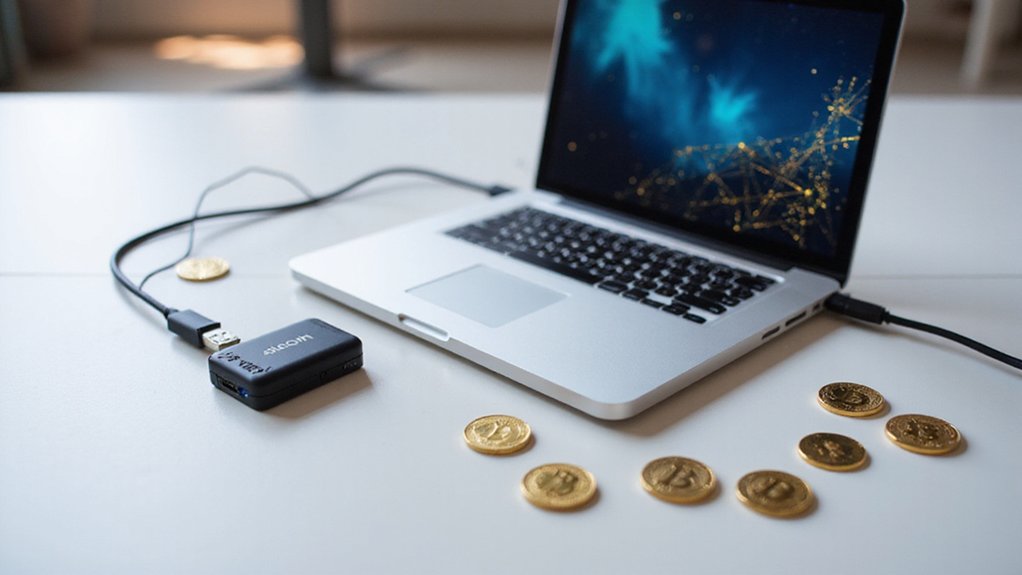Blockchain functions as a distributed digital ledger that records transactions across multiple computers, creating an immutable chain of cryptographically-linked blocks that eliminates traditional intermediaries. Each transaction requires network-wide consensus before validation, transforming institutional trust into mathematical certainty through decentralized verification. Originally developed for Bitcoin, this technology now powers smart contracts, supply chain tracking, and decentralized finance applications across industries. The system’s transparency and security features address historical record-keeping vulnerabilities, though energy consumption and scalability challenges persist alongside its revolutionary potential for reimagining financial infrastructure.

Revolution—or perhaps evolutionary inevitability—arrived not with fanfare but through lines of code that fundamentally reimagined how humanity might record, verify, and trust digital transactions.
Blockchain technology represents a decentralized, distributed digital ledger that stores information in encrypted blocks connected chronologically through cryptographic chains—a structure that renders traditional intermediaries somewhat obsolete (much to the chagrin of certain banking executives).
A revolutionary ledger system that eliminates middlemen through cryptographic consensus—transforming trust from institutional faith into mathematical certainty.
Each block contains transaction data, timestamps, and cryptographic hashes linking to previous blocks, creating an immutable chain where altering historical records requires network-wide consensus—a feat roughly equivalent to convincing every participant in a town hall meeting to unanimously revise yesterday’s minutes.
This architecture eliminates single points of failure while distributing data across multiple network nodes, collectively managed by participants rather than centralized authorities.
The technology’s genesis lies in cryptocurrency transactions, specifically Bitcoin, yet its applications have expanded considerably beyond digital currency.
Smart contracts, supply chain tracking, asset management, and decentralized finance (DeFi) now leverage blockchain’s transparent, tamper-proof characteristics.
Industries from healthcare to real estate utilize this technology for maintaining data integrity—because apparently, trusting humans with record-keeping has proven historically problematic.
What distinguishes blockchain from traditional databases extends beyond mere technical specifications.
While conventional systems rely on administrators for validation and permit data modifications, blockchain employs consensus mechanisms where network participants collectively validate transactions.
This transparency allows all participants to view transaction histories, effectively democratizing financial verification processes.
The immutability factor deserves particular attention: once data enters the blockchain, modification becomes extraordinarily difficult without network consensus.
Cryptographic hashing secures each block’s connection to its predecessor, preventing double-spending and record manipulation—addressing age-old concerns about digital transaction authenticity.
Blockchain’s benefits include enhanced security, reduced intermediary costs, and faster cross-border transactions.
However, energy consumption and scalability issues persist, particularly with proof-of-work consensus mechanisms.
These challenges haven’t prevented widespread adoption across sectors seeking transparent, secure record-keeping solutions.
The technology finds particular utility in asset tracking across various industries, where maintaining transparent and chronological records proves essential for verification and authenticity.
Before transactions become part of the permanent record, they are initially sent to a memory pool where they await validation and inclusion in new blocks.
Despite its reputation as “unhackable,” blockchain remains vulnerable to 51% attacks where malicious actors gain control over the majority of the network’s computing power.
Ultimately, blockchain represents trust mechanized—replacing faith in institutions with faith in mathematics and consensus, a shift that may prove either revolutionary or simply long overdue.
Frequently Asked Questions
How Much Energy Does Blockchain Technology Consume?
Blockchain energy consumption varies dramatically by consensus mechanism.
Bitcoin’s proof-of-work protocol devours 90-160 TWh annually—rivaling entire nations like Australia—with each transaction consuming energy equivalent to hundreds of thousands of VISA operations.
Meanwhile, proof-of-stake networks like Cardano sip a mere 6 GWh yearly.
The disparity reflects fundamental design choices: computational brute force versus validator elegance, creating an environmental chasm that makes traditional banking seem positively green by comparison.
Can Blockchain Be Hacked or Is It Completely Secure?
Despite blockchain’s cryptographic foundation, complete security remains elusive—a reality underscored by 2024’s $40.9 billion in illicit cryptocurrency flows.
While tamper-resistant by design, blockchains face evolving threats including 51% attacks (Ethereum Classic lost $9 million in 2020), smart contract exploits, and Sybil attacks that compromise network integrity.
The expanding attack surface grows with each new protocol and application, proving that mathematical elegance cannot entirely shield against human ingenuity.
What’s the Difference Between Public and Private Blockchains?
Public blockchains operate as open networks where anyone can participate, verify transactions, and access complete transparency—think Bitcoin’s radical democratization of financial records.
Private blockchains, conversely, restrict access to authorized participants, sacrificing the decentralization that makes blockchain theoretically unhackable¹ for enterprise control and privacy.
While public chains offer immutable, censorship-resistant ledgers supporting diverse ecosystems, private variants allow transaction modifications and operate in relative isolation—essentially defeating blockchain’s original promise.
¹As previously discussed regarding blockchain’s hackability through centralization vulnerabilities.
How Long Does It Take to Process a Blockchain Transaction?
Blockchain transaction processing varies dramatically across networks, creating a fascinating study in technological trade-offs.
Bitcoin transactions require 10-60 minutes for reliable confirmation (3-6 blocks), while Ethereum’s ERC-20 tokens take 1-30 minutes depending on gas fees.
More efficient networks like Tron and Binance Smart Chain process transactions in mere seconds.
Network congestion, transaction fees, and consensus mechanisms determine speed—proving that decentralization often comes at the cost of efficiency.
Do I Need Special Software to Use Blockchain Applications?
Most users need surprisingly little specialized software to access blockchain applications—web browsers and mobile apps suffice for most decentralized applications (dApps).
Wallet software like MetaMask enables seamless interaction with smart contracts without running full nodes.
However, developers require more sophisticated tools: Solidity compilers, node software (Geth for Ethereum), and Linux-based systems.
The irony? While blockchain promises decentralization, most users rely on centralized interfaces to access it.









